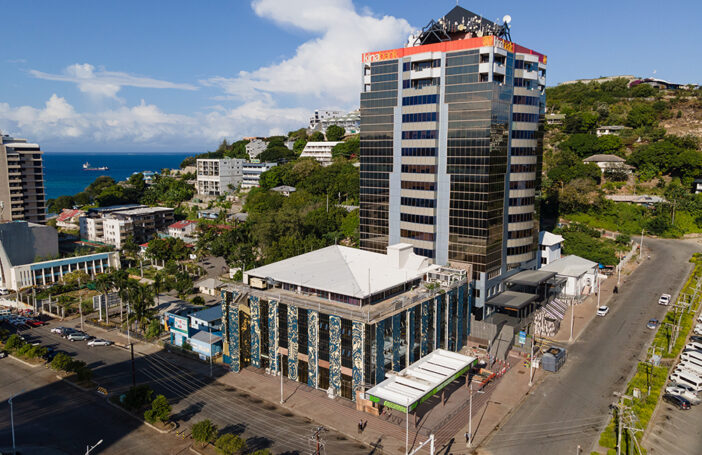Fiscal consolidation has been a central focus of PNG’s fiscal policy in recent years, with the ongoing IMF program bringing particular emphasis to the PNG government’s goal of eliminating the budget deficit by 2027. In most countries around the world, fiscal consolidation is accompanied by significant reductions in government expenditure and slower economic growth. Yet PNG seems to have avoided most of these negative impacts. Instead, the non-resource economy has grown faster in 2021 and 2022 than over much of the last decade, and government expenditure continues to increase, albeit at a slower pace than revenue.
The plan seems to be to grow out of the current budget deficit, with the 2024 budget projections expecting non-resource growth to remain steadily elevated until 2028 and government revenue projected to keep increasing enough to cover rising expenditure. But how realistic are the revenue projections in the 2024 budget?
Most strikingly, forward projections for resource revenue (that is, mining and petroleum tax and dividends) from the 2024 budget are much higher than in budgets from the last 5-10 years (Figure 1, left panel). If these projections prove accurate, resource revenue would remain at current highs and account for around 13-20% of total government revenue between 2024 and 2028 (Figure 1, right panel). This is significantly higher than the 8.7% of total revenue that resources have provided on average between 2012 and 2022. But looking further back into PNG’s history suggests that this level of dependency on resource revenues is not out of place, and that we might be seeing something of a natural correction after a particularly lean decade for resource revenue.
Figure 1: Resource revenue – mining and petroleum tax and dividends

Created by Datawrapper. Source: PNG Budget Database; 2016-2024 PNG government budgets (volume 1).
PNG’s other major taxes are also projected to grow much faster than they have in recent years in the 2024 budget. As Figure 2 shows, the average annual growth rates implied by the revenue projections from 2024 to 2028 for personal income tax (PIT), company tax (CIT) and taxes on goods and services (GST) are more than double what has been achieved in the last decade.

The projections also suggest that collections from these major taxes would have to grow either at their historical average annual growth rate or faster in order to meet current expectations of revenue collections by 2028. Specifically, PIT and CIT would both have to grow at a similar rate to the average annual growth between 1989 and 2022, while GST is expected to rise consistently and significantly faster than has been previously recorded.
It is certainly possible that the non-resource economy may continue to pick up speed, bringing higher revenues along with it – but this seems like quite a big ask. There isn’t much detail in the budget papers on what will drive this level of revenue growth either. PIT growth in 2024 is mostly predicated on “a favourable economic growth outlook, strong employment growth and improved tax compliance efforts by the Internal Revenue Commission (IRC)” (2024 budget, volume 1, page 60). The CIT estimate for this year is “underpinned by continuous strong corporate earnings on the back of robust non-resource sector growth and the corporate tax rate of 45% levied on the commercial banking sector in 2023.” And growth in GST in 2024 is attributed to the IRC’s “ongoing tax compliance and enforcement efforts” and strong consumption fuelled by economic growth.
How reliable can we consider these 2024 budget projections to be? The volatility of resource prices makes resource revenue notoriously difficult to predict accurately. But comparing projections from past budgets to actual collections may give an indication of how accurate revenue projections for other major taxes have been in previous years.
As Figure 3 shows, actual collections of personal income tax have consistently underperformed relative to optimistic expectations over time in budgets from 2016 onwards. For company taxes, projections prior to the pandemic repeatedly failed to account for the downward trend in company tax collections that continued until 2021; since then however, collections have grown and outstripped significantly more cautious projections in recent years. GST projections appear to align most closely with actual collections, with projections appearing to be relatively accurate compared to other major sources of tax revenue.
Figure 3: Revenue from major taxes
Created by Datawrapper. Source: PNG Budget Database; 2016-2024 PNG government budgets (volume 1).
Ultimately, broad-based growth across various revenue sources – including resource revenue – underpins the prospect of fiscal consolidation in PNG. To meet the targets set out by the projections, revenue collections from most major taxes will however have to grow much faster than they have in recent years, by matching or exceeding the average rate of growth PNG has achieved in the past.
Is this really achievable? The government’s projections have often been overly optimistic in the recent past, at least for PIT and CIT, and this casts some doubt on whether the targets set in the budget can be met. However, the “green shoots” represented by new resource projects coming online and continued growth in the non-resource economy shouldn’t be ignored.
Whether PNG can continue to defy gravity on the path to fiscal consolidation ultimately remains to be seen. In the meantime, a healthy dose of caution is in order.
This blog uses data from the PNG Budget Database, which has been updated with data from the 2024 government budget.




